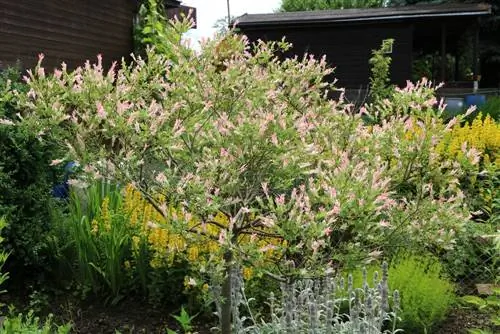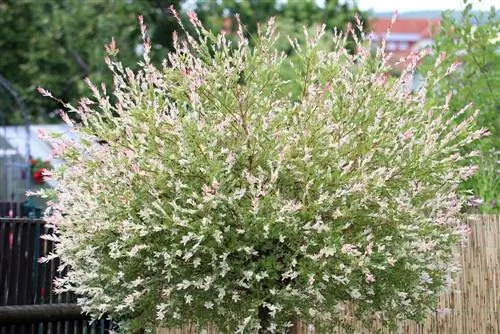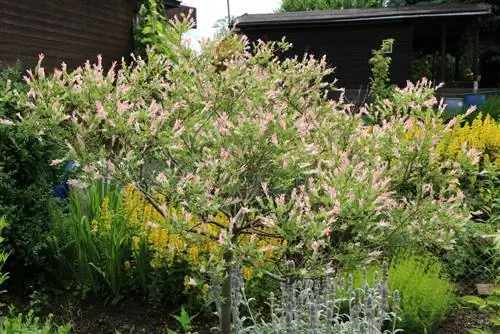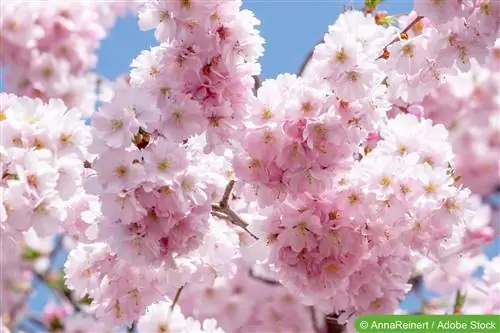- Author admin [email protected].
- Public 2023-12-17 03:39.
- Last modified 2025-06-01 06:48.
Harlequin willows with their colorful leaves and shoots are a distinctive and popular representative of Salix integra. The ornamental trees are particularly undemanding, but tend to go wild. In order to promote the he althy appearance of the plant and to get the strong growth under control, regular pruning is almost essential. This is especially true if the ornamental willow has been grown into a standard tree. With the right pruning measures, you will retain the spherical crown of leaves.
Profile
- Growth: densely bushy shrub or standard tree, cut in autumn/spring
- Growth height: can grow up to 2 meters high
- Leaves: elongated, white-green, the new growth is slightly pink, they are shed in autumn
- Flower: inconspicuous
- Location: full sun but also partial shade
- Soil requirements: no special requirements, normal soil, with sand an advantage
- Winter: can overwinter well outdoors, as a potted plant also indoors in a cool, bright place
- Special feature: very easy to cut
- Growth per year: half to one meter
Salix integra - the colorful-leaved beauty
The Harlequin willow is a decorative shrub whose breeding origins lie in Japan. The tree from the land of the rising sun is one of the most diverse ornamental plants that constantly shine in new splendor as the seasons change. Salix integra can reach a height of up to 3 meters, which makes the ornamental plant particularly interesting for small gardens and front gardens. The pussy willows appear long before the leaves emerge in spring; the white to pink leaves are an eye-catcher in summer and resemble small flowers. In winter, however, the reddish and yellowish branches bring variety to the otherwise dreary winter landscape.
Salix integra “Hakuro Nishiki” - the correct Latin name for the harlequin willow - can also be cultivated in larger planters due to its compact growth. However, the variegated willow variety requires a full sun to partially shaded location to develop its brightly colored leaves. If the leaves take on a pale or green color, the ornamental tree is suffering from a lack of light and should be moved to another location. Caring for the fast-growing ornamental trees also includes regular pruning. Whether pruning or pruning is necessary depends on the growth habit of the respective harlequin willow. Ornamental willows grown into tall trunks are usually available from specialist retailers.
The correct pruning of shrubs
With regard to pruning the ornamental willow, a distinction must be made between standard and shrub forms. The ideal time for any type of cutting is in spring, before the willow begins to vigorously sprout leaves and shoots. If the measure is carried out in the fall, the edges of the wound close poorly. This can be an ideal breeding ground for fungal pathogens, and frost can also have a huge impact on such weakened plants. You don't have to worry about making mistakes when pruning, because willows are almost indestructible. Bare or incorrectly pruned areas quickly disappear due to the rapid growth of the plants. Avoid using electric hedge trimmers. Tools of this type usually cause more harm than good.

In their original form, all harlequin willows sprout like bushes. These trees take up a lot of space, so there is no need to plant spring bloomers under them. Shrub-like ornamental willows usually do not require annual pruning. These trees are particularly effective as an enrichment to a privacy hedge. However, every now and then it is unavoidable that Salix integra has to be shortened. Because older shoots become very woody and these areas become bare.
- Remove old and weak shoots completely.
- Dead and diseased branches can be cut all year round.
- Plants that are too large can be shortened by 2/3.
- Willows that have been cut close to the ground also sprout vigorously.
You can use slightly woody, cut shoots to propagate the harlequin willow. Shorten the branch to around 10 cm and remove all of the foliage except for two pairs of upper leaves. The cuttings are rooted in a container filled with water or directly in the substrate. Keep the soil evenly moist, as dryness damages root development. Use the mass of the cut shoots and take as many cuttings as possible. As much as Salix is keen to grow, the plants are just as tricky when it comes to vegetative propagation. It is also not unusual for the trees grown in this way to have different characteristics than the mother plant. Because some breeders of the variegated willow variety refine their plants, many positive characteristics, such as leaf coloring and patterning, cannot therefore be passed on via cuttings. Nevertheless, you get a robust plant that can be easily and easily cultivated in the garden.
Pulling and cutting tall trunks
Whether it's a shrub or a standard tree, the harlequin willow shines in its full splendor with both growth forms. In order to maintain and optimally promote their spherical appearance, these ornamental willows require annual training and thinning. When shortening the shoots, use the spherical shape as a guide. However, obtaining this requires a lot of skill and a good sense of proportion. Don't despair if it doesn't work out, because ornamental willows are very tolerant of cutting. The rapid growth of the plants provides more frequent opportunities to practice. If the weather is favorable and the care is ideal, a second and third topiary is also possible. To encourage even sprouting, the shoots are shortened directly above one eye.
- In February and March, the ornamental trees can be cut back by up to 1/3.
- Annoying, weak and dead shoots are also removed at this time.
- Prune heavily sprouting branches regularly during the main growing season.
- Remove wild and side shoots.
The dense network of branches encourages birds to seek refuge between the shoots and build nests there. Between March and September you should therefore completely avoid radically pruning the ornamental tree. Older shoots of Salix integra are particularly susceptible to diseases and have little resistance to pests. Regular pruning of the plant contributes to a he althy appearance of the entire plant and promotes its resilience. Twigs and leaves that are already infected should not be disposed of in the compost, but rather directly with the residual waste.
Tip:
Salix integra is extremely susceptible to pests. Clean the garden tool thoroughly before and after work to limit the spread of harmful insects and fungal pathogens.
With tall trunks you have to pay attention to a balance between trunk and crown. Especially with Salix integra “Hakuro Nishiki” in planters, there is often the problem that the willow trunk can only develop moderately due to a lack of space and nutrients. In order to avoid damage caused by wind throw or top-heaviness, you should avoid an overly lush foliage crown on potted plants.
Dissemination and use
The ornamental willow is originally widespread in East Asia. In China, Japan, Korea and Russia it grows along watercourses and in wet meadows. The Harlequin willow is usually grafted onto a pasture of another variety and sold as a standard tree. Willows are suitable as solitary trees. Smaller forms, such as the ornamental willow, can become an eye-catcher in the lawn or flower bed. Because of their growth, they always cut a good figure on the edges of ponds and streams. If the ornamental willow is kept in a bucket, it should be fertilized occasionally. Appropriate fertilizer is available from specialist retailers. In the form of liquid fertilizer it is added to irrigation water or added to the soil as a depot.
Wintering

The Harlequin willow is frost hardy and can remain outdoors over the winter. As a container plant, it can also be brought into the house at this time in a cool and bright place. The willow then has a small head start in growth and flowering in spring.
What you should know in brief
- The ornamental willow 'Hakuro Nishiki' tolerates cutting very well. It should even be cut generously.
- If you don't cut, the crown will become very large and quite tangled. The proportions are then no longer correct.
- The quite short and usually quite thin trunk does not match the lush crown. In addition, the crown is balding from the inside.
But the most important thing is that the beautiful variegated leaves of this special willow only bloom on this year's wood. So if you don't cut, the leaves will fade and nothing of the special nature of the willow will remain! When cut, however, it becomes nice and dense and looks he althy.
- Cutting is best done in late winter, i.e. in February on a frost-free day without sun.
- It's enough if you leave cones about 5 cm long, everything else can go.
- The tree sprouts quickly and reliably. The round shape can then be trimmed again in late summer.
- The more the ornamental willow 'Hakuro Nishiki' is trimmed, the better it develops and is a real highlight in the garden.
Conclusion
Harlequin willows are a nice addition to the garden, but do not place any special demands on the hobby gardener in a planter. The rapid growth of the ornamental willows makes pruning and thinning almost mandatory. Salix integra “Hakuro Nishiki” with a spherical foliage crown, especially grown into tall trunks, must be cut into shape several times a year. Even beginners can't go wrong when pruning the harlequin willow itself, because the trees are extremely tolerant of pruning.






